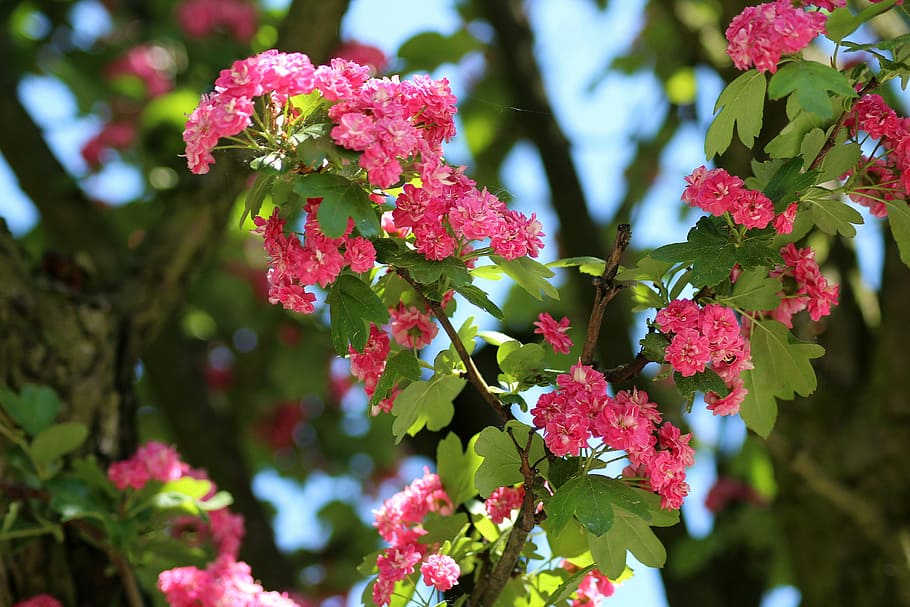Table of Contents
Imagine having a plant in your backyard that displays all-year-round stunning blossoms, peeling bark, and attractive autumn colours—that’s the elegance of crepe myrtle (Lagerstroemia). Crepe myrtle, a deciduous tree or shrub, produces clusters of colourful blooms in red, white, pink, purple, and lavender hues that attract honeybees.
Lagerstroemia is a sunlight-loving, easy-to-grow tree that can survive in harsh conditions. It seems too good to be true, does it? We’ll cover every fact you need to know about this gorgeous tree in the blog “How to Grow & Care for Crape Myrtle (Lagerstroemia).” You will get information on picking and growing the best variety and fertilising it, along with suggestions to maintain crepe myrtle for its health and form.
Let’s begin the process of growing and caring for crepe myrtle.
Overview of the Shrub Crepe Myrtle (Lagerstroemia)
The crinkled appearance of the flower petals, which look like crepe paper, gave rise to the moniker “crepe myrtle.” The leaves are deep green that turns yellow, orange, and red in the autumn. If you peel away the outer part, you can see a smooth, structured inner bark that ranges from brown to grey. This tree is known as “saru suberi” in Japanese, which means “monkey slip” due to its smooth, slick bark.
| Scientific Name | The scientific name of crape myrtle, or crepe myrtle, is Lagerstroemia. |
| Family | Crape myrtle is a flowering plant from the Lythraceae family, which includes 50 different types of deciduous and evergreen trees and shrubs. |
| Place of origin |
The plant is indigenous to China, Korea, Japan, Southeast Asia, and the Indian subcontinent. |
| Crepe Myrtle type – Commonly grown in the UK | In the United Kingdom, the most ubiquitous species is Lagerstroemia indica, or common crape myrtle. Depending largely on the variety, the height of the tree may vary from 3 to 30 feet. |
Benefits of Growing Crape Myrtle
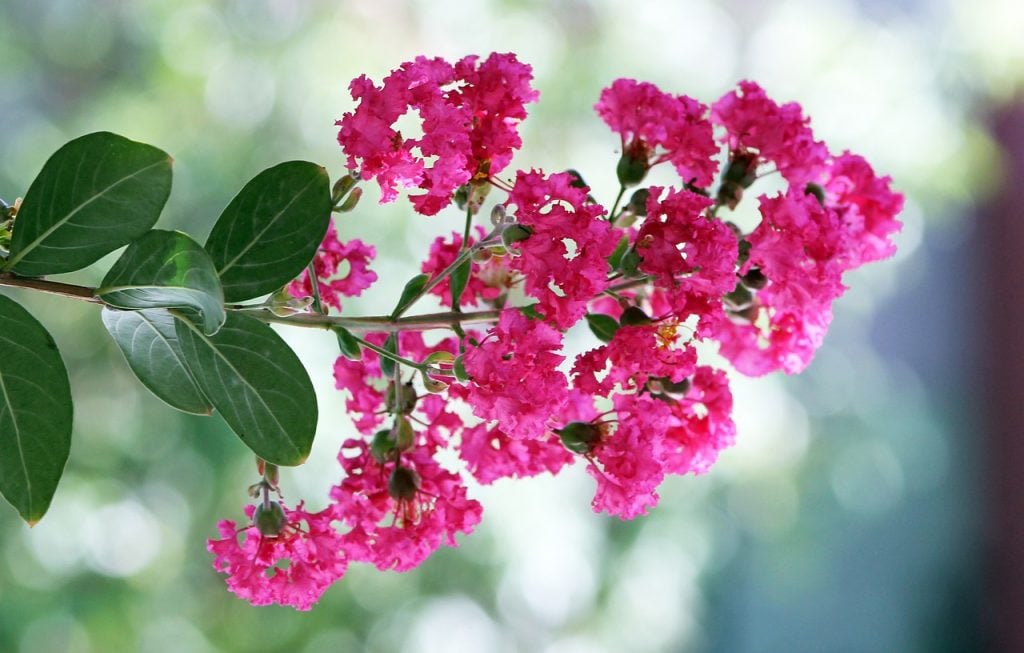
You must consider growing Crepe myrtle (Lagerstroemia) in your garden or landscape for more than one reason.
- First off, it has a distinct bark. It might peel off in layers, exposing the various hues underneath. The bark can range from smooth and grey to mottled and brown, depending on the plant’s specific variety. The bark adds interest and texture to your garden, especially in the winter when the leaves cede from the crepe myrtle.
- Second, the crape myrtle has lush green foliage that provides shade and contrast to the flowers. The leaves are oval-shaped and glossy and turn into brilliant colours during autumn, from yellow to orange to red.
- Third, crepe myrtle has showy summer flowers that last for weeks. The flowers form large clusters at the end of the branches and bloom in various colours, from pink and purple to red, white, and lavender. The flower attracts birds, butterflies, and bees, thus enhancing life and beauty in your garden.
- Crape Myrtle can also add value to your garden or landscape by enhancing its curb appeal and upgrading the value of your property. Now you notice that it is a low-maintenance tree that can tolerate drought, heat, and pests as well.
- If you water Lagerstroemia adequately, it can flourish in different pH values and soil types. You can prune it to different shapes and sizes as a shrub or a tree. Crepe Myrtle is a versatile and adaptable tree that can suit any style and preference.
An Ideal Place to Grow Crepe Myrtle
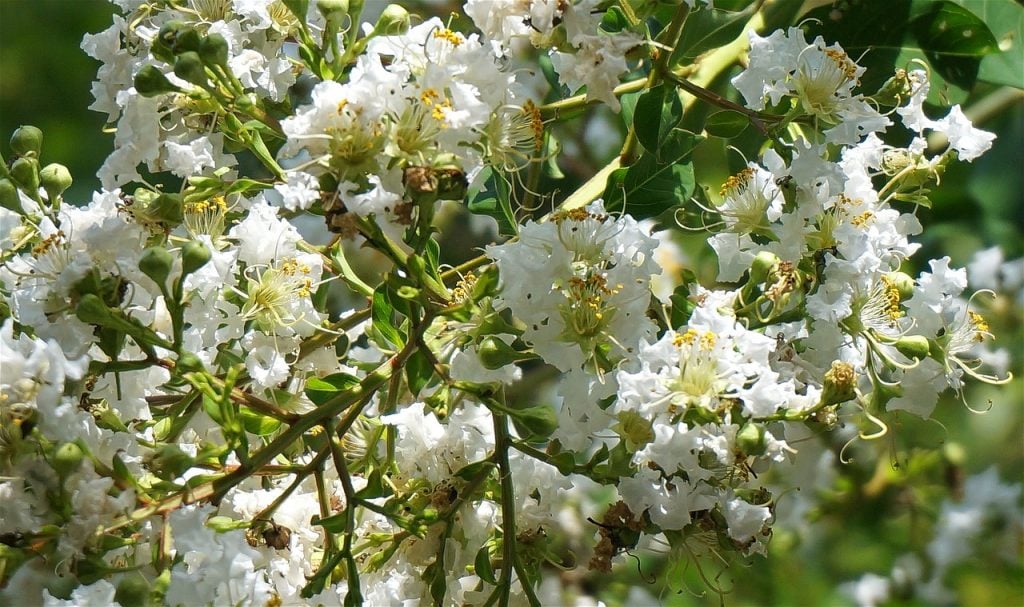
Crepe myrtle planting is a bit like growing other trees and plants, but you should be familiar with the best-suited location for this species to give your plant a chance to grow healthily.
- Crepe Myrtle seeks warm, protected, and sunny locations.
- Its hardiness level is H3, but as the plant takes root, its timber matures under the sun and grows harder. When sufficiently mature, even a dormant tree may survive at -10°C.
- In the UK’s climatic conditions, a bright southbound spot is suitable for cultivating common crape myrtle. The expert gardeners noticed that in the south, flowers bloom profusely during summertime.
- If the temperature is pretty low and frosty outside, you can keep crape myrtle indoors in a sizable glass vessel. When the weather is sunny, quickly move the plant into the open since heavy shade can reduce flowering.
How to Grow Crape Myrtle
You can grow crape myrtle without hassles, provided it gets the right growing conditions. It prospers well under bright sunshine and needs at least six hours of direct sunlight during twenty-four hours.
It also needs well-hydrated soil but dislikes staying wet or soggy. It also makes the tree more susceptible to leaf spot diseases.
1. Planting Crape Myrtle
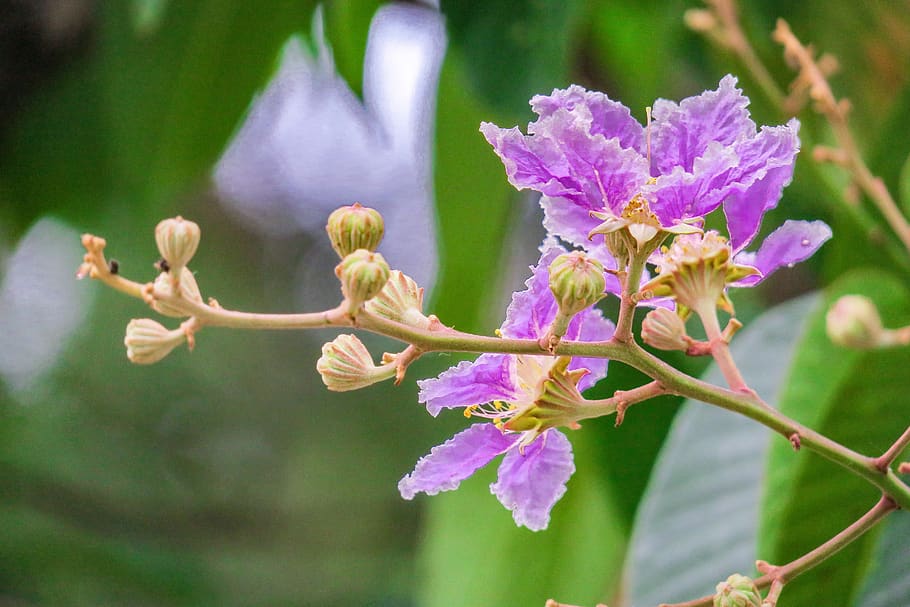
Learn how to plant a crape myrtle step by step right now.
Step 1:
- For planting Crape Myrtle, first, dig a planting hole that is twice as wide as the root ball or tuber and as deep as the root ball. The crown of the tree should be slightly above the soil level.
- Proper spacing ensures that the tree has enough room to grow. Keep the spacing between trees at least 10-15 feet in your garden, depending on the variety of Crape Myrtle.
- Early spring or autumn end, the soil has moisture, and the weather turns pleasant, which is the ideal time to plant crape myrtles.
- It will blossom more as it receives more sunlight.
Tip: If you want to grow this plant in your garden, buy a bigger-sized crepe myrtle with well-developed tubers because it often fails to transplant successfully.
Step 2:
- The tree’s growth and health depend on proper care. Crape Myrtle requires sufficient watering and fertilising.
- The tree has a shallow, fibrous root system and requires regular watering, especially during dry periods.
- Water the tree deeply, but avoid watering the foliage to prevent powdery mildew. Mulching around the tree base can help it to retain moisture and protect against weed pressure.
- By including natural materials like compost or peat moss, you can upgrade the drainage capacity of your garden soil.
- Fertilising Crape Myrtle is integral for new growth. The tree benefits from an annual application of fertilisers in the proportion of 8-8-8, or 13-13-13, or slow-release fertiliser in early Spring. However, if the tree is growing well and producing a lot of leaves, it may not need fertiliser.
Tip: The 13-13-13 fertiliser is applied more often because it contains potash, nitrogen, and phosphate in a higher quantity than the 8-8-8 level.
2. Crape Myrtle Tree Propagation
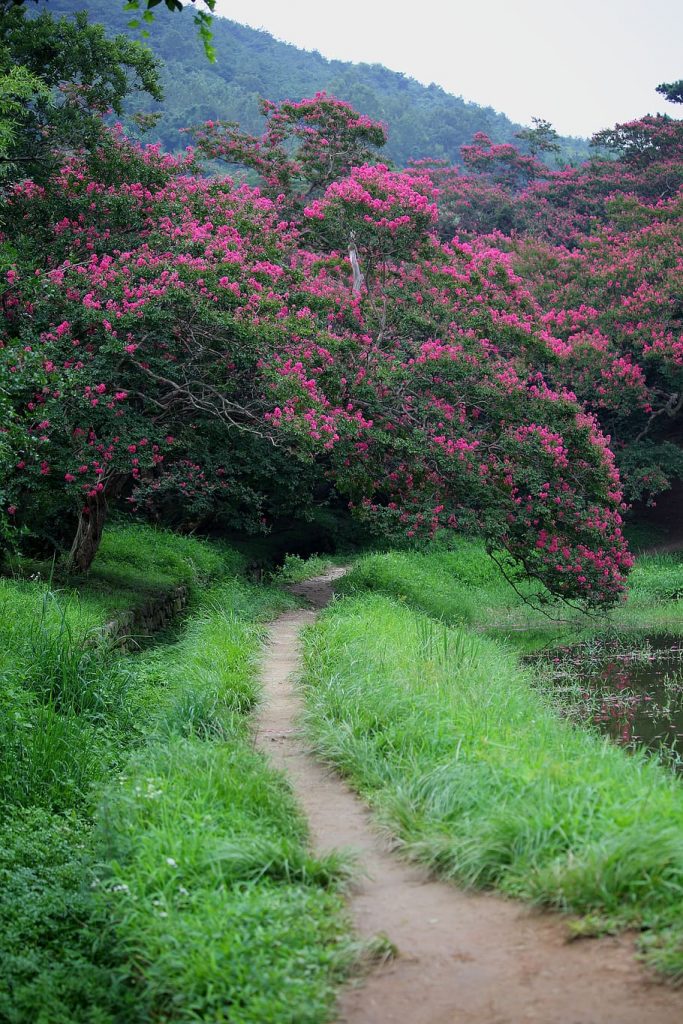
In the UK, crape myrtles rarely produce viable seeds. Hence, propagation through softwood cuttings is the solution for this. Propagation of crape myrtle is easy.
Follow the below-mentioned steps to propagate the plant successfully.
- Collecting and transplanting root cuttings during the growing season in the months of June, July, and August is ideal for this procedure.
- Pick a few leaves and 3 to 4 knobs from the season’s fresh growth per cutting. Cuttings ought to sprout in three to four weeks without the use of rooting hormones.
- Always plant the cuttings in a shaded place in a moist rooting medium. To retain the cuttings moist, place them inside a clear plastic bag.
- Additionally, you can create outdoor rooting beds and place the cuttings in them. Make a hole of 10-12 inches in the soil.
- Mix organic materials such as pine bark, peat moss, or compost in 4-5 inch layers and carefully blend them into the soil.
- Aim for a spacing of 6 inches between the cuttings. Place them on the grounds halfway along their length. To retain moisture, mulch the soil with up to three inches of pine hay, bark, or leaf mould.
- Spray them frequently to keep them moist. In the autumn and winter, you may transfer the newly established trees to their final spot.
Caring for Crape Myrtle
Pruning is a vital aspect of caring for crepe myrtle. You may prune your tree whenever you notice dead, unhealthy, or infected branches. Proper pruning can promote healthy growth and beautiful blooming.
Things to Remember
- Prune as soon as the flowers have finished blooming to prepare for the next flowering season.
- Pruning should be done in the later winter or early Spring before growth begins. You should trim the tree to allow better air circulation and light penetration.
- Dead-heading blossoms will help your crepe myrtle bloom once more if it is an older variety that does not remain in the blossoming stage for a prolonged period. This may even result in your plant blooming several times a year.
- The delicate, peeled bark of huge crape myrtles is something you don’t want to ignore. To show off the stunning bark and magnify its attraction in your garden, remove branches at least 4 to 5 feet from the tree’s base.
- Beware of excessive pruning. It can reduce the tree’s blooming potential. Avoiding rounding over the tree is also crucial, as it can promote the development of weak branches and unwanted suckers.
Protecting Crape Myrtle from Ailments
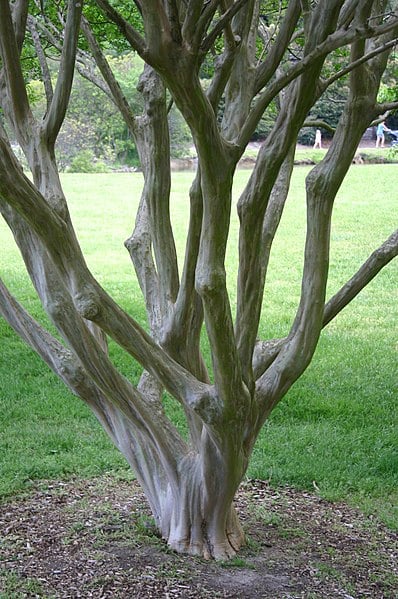
Here are some of the ways through which we can protect Crape Myrtle:
- Crape myrtle is prone to several diseases and pests, for example, aphids, powdery mildew, and Japanese beetles. You should plant the tree in a sunny location with good air circulation to prevent diseases.
- Proper watering and fertilising can also help prevent disease and pest issues. You may treat the plant with fungicides or insecticides. It is prudent to follow the instructions on the label when using a product.
- Never delay preparing crape myrtle for winter to make them tolerant of cold. Its USDA hardiness zone is 7-9. Although this variety is easy to maintain plant, in colder regions, it might need some protection.
- While helping the tree get ready for winter, you must hydrate it well during the autumn. The mulching at the tree base can help keep the roots from being frozen in cold weather.
Tip: Wrap the tree in hessian or another suitable material to enhance the warmth.
Conclusion
Crape myrtle is an ideal tree to grow in your garden. Implementing the planting advice from this blog, you can create an aesthetically pleasing landscape in your yard.
The best period for planting Crepe Myrtle is the onset of Spring or the latter part of autumn. The plant likes a sunny area in your garden. It will blossom more as it receives more sunlight. Red, lavender, or white flowers bloom in the summertime.
It is better to start pruning at the end of the winter season. In the colder regions, drape gunny fabric on the tree to shield it from the cold. Crepe Myrtle is a hardy plant that needs little maintenance.
By including natural materials like compost or peat moss, you can upgrade the drainage capacity of your garden soil. Inappropriate watering and fertilising may trigger plant infections and ailments.
We hope you found the information on growing and caring for crepe myrtles useful. What’s stopping you now? Don’t miss this chance to add some crape myrtle to your landscape!

